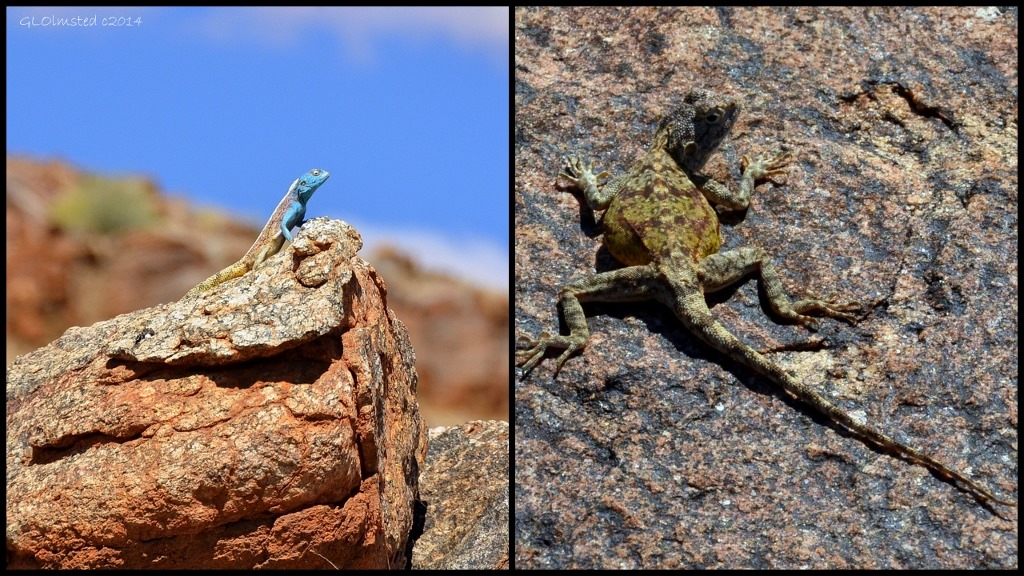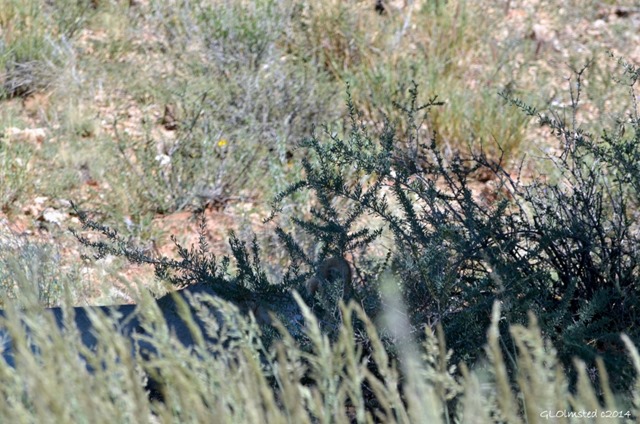The world’s largest antelopes with males weighing in from 1300-1500 pounds. Saw these two male elands at Addo Elephant National Park, South Africa. Must be young bachelors as dominant males travel alone and females gather in large groups.
Unusually heavy Autumn rain brought exciting water energy at Augrabies Falls National Park with the thundering falls, a soggy hike and floating tent which gave us an excuse to stay in a chalet for my birthday.
After leaving the Kgalagadi early due to poor road conditions and a shopping stop in Upington Joan and I headed for the 10th, and last, National Park of this South Africa diversity Eco Tour, Augrabies Falls. Because of high rainfall the Orange River ran in full force with water flowing at 30,017 cubic feet (850 cubic meters) per second making for a very impressive drop of 183 feet (56 meters) and living up to its Khoi name ‘Aukoerebis’ meaning Place of Great Noise.
Set up camp, walked to falls and hiked in a storm
We found a camp site in semi-shade with no near neighbors, set up my tent and walked to several of the Augrabies Falls overlooks. Note to self, don’t camp on the lowest ground.
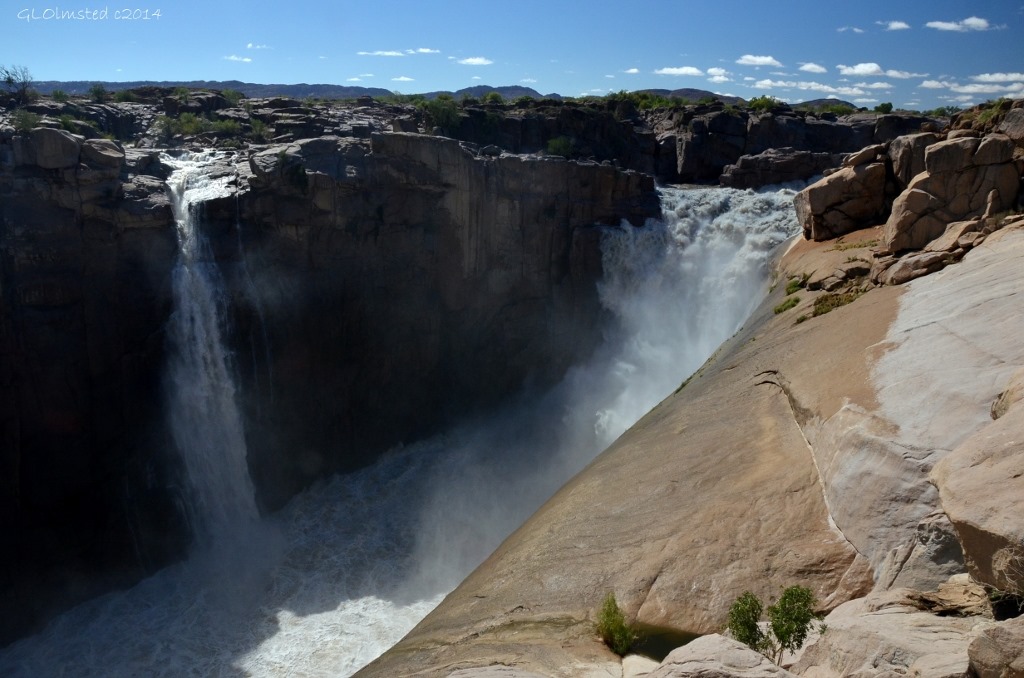 Really nice raised boardwalks keep you from slipping on moist misted boulders. The flow was impressive. Joan said the previous August the flow was about 1/3 of what we saw. This raised trail leads to several overlooks above, next to and below the falls. All an easy walk from the camp and reception area.
Really nice raised boardwalks keep you from slipping on moist misted boulders. The flow was impressive. Joan said the previous August the flow was about 1/3 of what we saw. This raised trail leads to several overlooks above, next to and below the falls. All an easy walk from the camp and reception area.
 And these colorful Augrabies flat lizards crawled all over the boulders and the decks.
And these colorful Augrabies flat lizards crawled all over the boulders and the decks.
 Then we decided to tackle the 3 mile (5 km) Dassie Nature Trail, a loop that follows along the gorge to Arrow Point, then out onto boulders to Moonrock before heading back to camp. Easy peasy.
Then we decided to tackle the 3 mile (5 km) Dassie Nature Trail, a loop that follows along the gorge to Arrow Point, then out onto boulders to Moonrock before heading back to camp. Easy peasy.
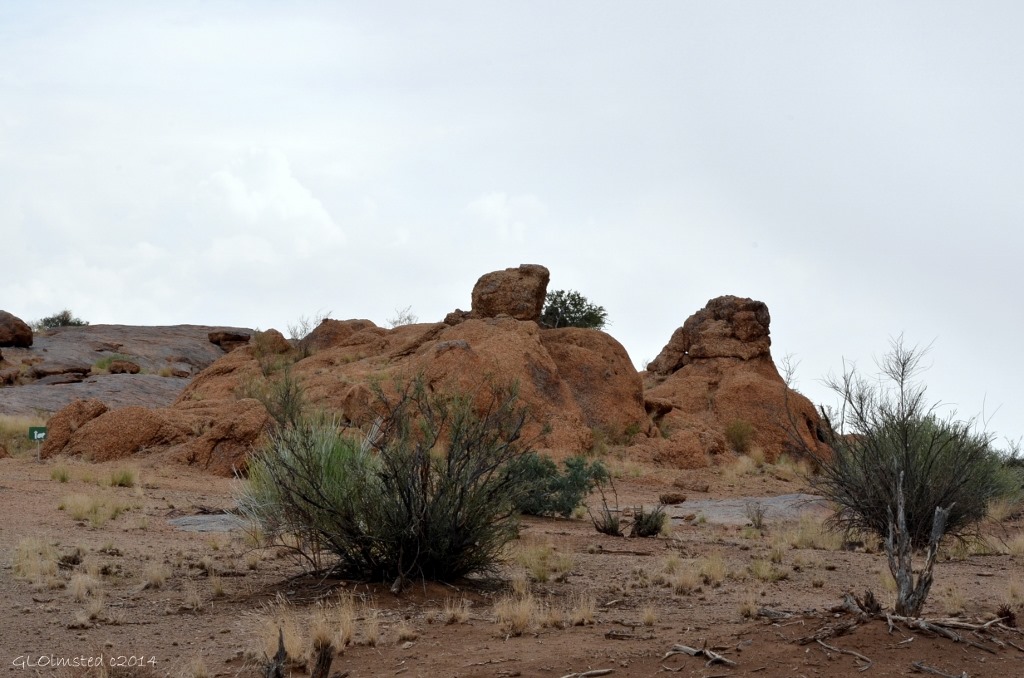 Until storm clouds headed towards us about half way followed by rain with thunder and lightning. Thank goodness it was warm but the only place to hide was huddled against giant boulders which we did until streams of water began to flow all around us.
Until storm clouds headed towards us about half way followed by rain with thunder and lightning. Thank goodness it was warm but the only place to hide was huddled against giant boulders which we did until streams of water began to flow all around us.
 With cameras tucked under damp shirts we made a beeline for the road back to camp and the cloud burst moved on. Although soaking wet it was still an awesome hike.
With cameras tucked under damp shirts we made a beeline for the road back to camp and the cloud burst moved on. Although soaking wet it was still an awesome hike.
Rained all night and woke up in a lake
 It was an early night for us two tired hikers plus it continued to rain. And it rained all night. Joan was dry sleeping in the back of her truck. And I slept fine with the sound of rain on the tent. But in the morning I noticed a trickle of water from a floor corner and quickly stacked all my stuff on the air bed. When I unzipped the door to step out the lake surrounding our camp was at least 5 inches (12.7 cm) deep. Gives a whole new meaning to waterbed. I rescued Joan’s flip-flops that had floated away, waded to the bathroom then hopped into the cab with my coffee. Not a happy camper.
It was an early night for us two tired hikers plus it continued to rain. And it rained all night. Joan was dry sleeping in the back of her truck. And I slept fine with the sound of rain on the tent. But in the morning I noticed a trickle of water from a floor corner and quickly stacked all my stuff on the air bed. When I unzipped the door to step out the lake surrounding our camp was at least 5 inches (12.7 cm) deep. Gives a whole new meaning to waterbed. I rescued Joan’s flip-flops that had floated away, waded to the bathroom then hopped into the cab with my coffee. Not a happy camper.
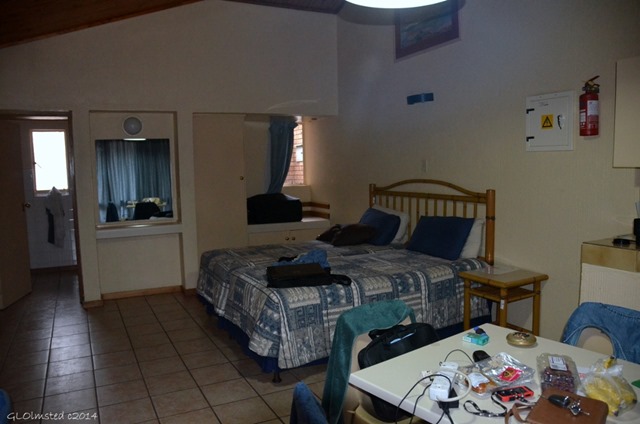 As soon as reception opened Joan called and we reserved a chalet for the next two nights. Very nice with two beds, sofa, bathroom, and fully stocked kitchen except for food. Was a little expensive but what the heck, it was my birthday.
As soon as reception opened Joan called and we reserved a chalet for the next two nights. Very nice with two beds, sofa, bathroom, and fully stocked kitchen except for food. Was a little expensive but what the heck, it was my birthday.
Then the sun came out so we laid out the tent and ground cloth to dry. After another walk back to the falls we drove to and climbed Moon Rock which we’d almost made it to the rainy day before. This prominent landmark is a massive exfoliation dome or “whaleback” of eroded granite. And the view of the park from the top was awesome.
 Plus we drove to some other overlooks of the Orange River gorge, an impressive example of granite erosion 787 feet (240 meters) deep and 11 miles (18 km) long.
Plus we drove to some other overlooks of the Orange River gorge, an impressive example of granite erosion 787 feet (240 meters) deep and 11 miles (18 km) long.
My birthday
Started off with a fine smoked salmon breakfast at the park’s restaurant. Then after another look at the falls we went for a drive.
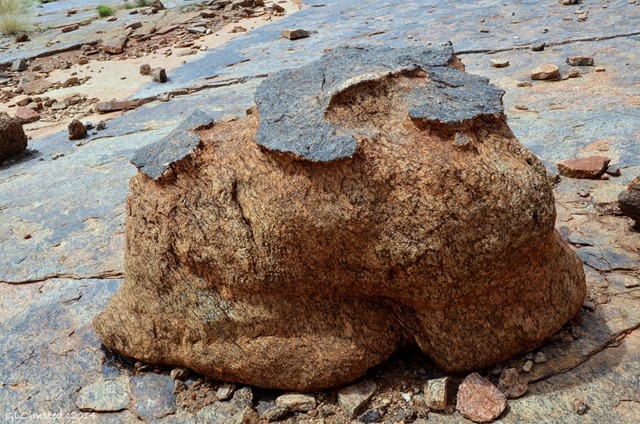 The drive winds through a geologic mix up of sediments, metamorphic and igneous rock with eons of erosion thrown in.
The drive winds through a geologic mix up of sediments, metamorphic and igneous rock with eons of erosion thrown in.
 The Black Hills are made of quartz-poor igneous rock that form a natural border between the harsh environment of the gorge area and a more fertile area on the other side.
The Black Hills are made of quartz-poor igneous rock that form a natural border between the harsh environment of the gorge area and a more fertile area on the other side.
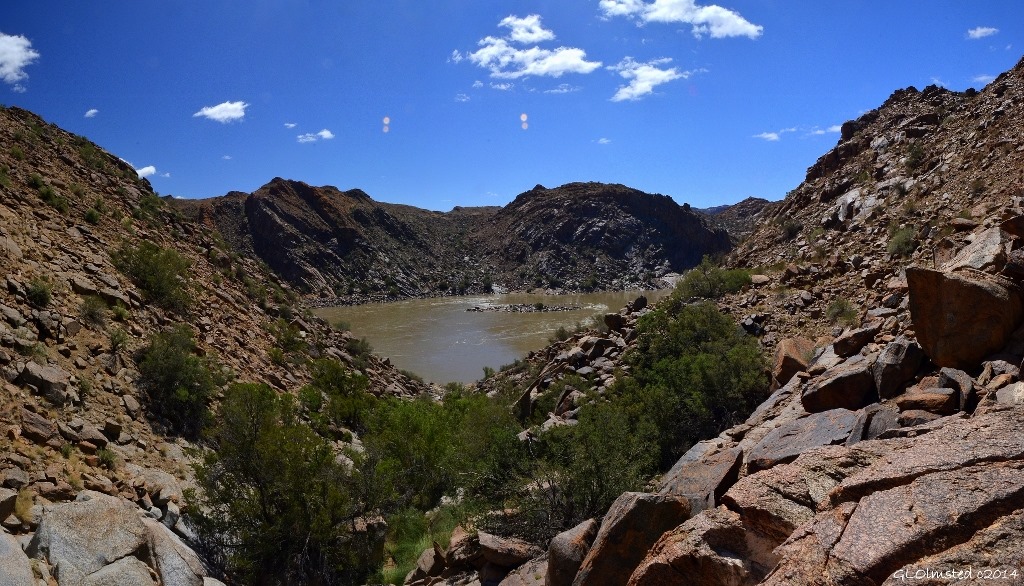 And the road to Echo Corner took us through some stunning scenery plus another view of the Orange River gorge. And yes, we tried to echo. Joan was unsuccessful, but I guess I have a louder voice as it worked for me.
And the road to Echo Corner took us through some stunning scenery plus another view of the Orange River gorge. And yes, we tried to echo. Joan was unsuccessful, but I guess I have a louder voice as it worked for me.
Plenty of diversity to excite the geologist and rockhound in me. Although no gathering in the park I was tempted with the fist-size and smaller chunks of rose quartz.
 Augrabies is situated in a semi-arid region so the vegetation is sparse. Yet it supports the unusual kokerboom, or quiver tree, which is a succulent that can store huge amounts of water in their stems and so survive long periods of drought.
Augrabies is situated in a semi-arid region so the vegetation is sparse. Yet it supports the unusual kokerboom, or quiver tree, which is a succulent that can store huge amounts of water in their stems and so survive long periods of drought.
There seemed to be a lizard on every rock.
 Well, except where the klipspringer rested. And we also saw springbok, tortoise, butterflies and birds.
Well, except where the klipspringer rested. And we also saw springbok, tortoise, butterflies and birds.
 Yet the best wildlife sighting, and most frequently seen, was giraffes. And these two males put on quite a necking show as they swung their heads back and forth, rubbing and intertwining for several minutes.
Yet the best wildlife sighting, and most frequently seen, was giraffes. And these two males put on quite a necking show as they swung their heads back and forth, rubbing and intertwining for several minutes.
 Joan took me out for a very special birthday dinner celebrating 60 in South Africa. Kitchen staff went the extra kilometer with our starter of garlic bread with cheese. For our main course Joan had schnitzel and I had kudu stroganoff with malva pudding for dessert. All eaten before a photo could be taken.
Joan took me out for a very special birthday dinner celebrating 60 in South Africa. Kitchen staff went the extra kilometer with our starter of garlic bread with cheese. For our main course Joan had schnitzel and I had kudu stroganoff with malva pudding for dessert. All eaten before a photo could be taken.
 Then we waddled to the falls for a night view with lights on the water and bats chasing the many insects.
Then we waddled to the falls for a night view with lights on the water and bats chasing the many insects.
The next day started our journey east back to Pilanesberg Game Reserve for 10 days over holiday.
Services and review
Shaded campsites with power, bathrooms with showers, and communal camp kitchen with two-plated stoves, and sinks, laundry and ironing room. Self catering chalets sleep 2-6 with lounge, kitchenette, bathroom and outside seating and BBQ area. Three swimming pools for overnight guests and one for day visitors along with restrooms and BBQ in picnic area. The Shibula Restaurant offers indoor and outside seating for breakfast, lunch and dinner. Easy boardwalks with steps to railed decks provide multiple views overlooking Augrabies Falls and the Orange River Gorge. In addition to the Dassie Nature Trail that we hiked, the Klipspringer Trail takes three days to cover 22.2 miles (35.8 km) through rugged terrain.
Spending 3 days at Augrabies Falls National Park was ideal. The two meals eaten at the restaurant were delicious and moderately priced with excellent service. Good thing we had food for the rest of our meals with us because the Park Shop had a limited selection. Internet connection was spotty at best even near reception.
 National Park #9 for my South Africa diversity Eco Tour, Kgalagadi Transfrontier Park, and I was really excited to see this remote northern landscape with red sand dunes and sparse vegetation. Even knowing we couldn’t see the entire park without a 4×4, I looked forward to visiting a place where the animals could be easily seen. Unfortunately for us unseasonal rains had watered the dry landscape and the grasses were tall. Which is great for the land and the animals, but not so much for wildlife sighting from a low riding 2×2 truck.
National Park #9 for my South Africa diversity Eco Tour, Kgalagadi Transfrontier Park, and I was really excited to see this remote northern landscape with red sand dunes and sparse vegetation. Even knowing we couldn’t see the entire park without a 4×4, I looked forward to visiting a place where the animals could be easily seen. Unfortunately for us unseasonal rains had watered the dry landscape and the grasses were tall. Which is great for the land and the animals, but not so much for wildlife sighting from a low riding 2×2 truck.
 Kgalagadi means place of thirst, yet due to heavy rains in early March the landscape was covered in green. Originally the Kalahari Gemsbok National Park in South Africa and and the Gemsbok National Park in Botswana the two parks were combined and in 2000 becoming the Kgalagadi Transfrontier Park, an area covering 15,000 square miles (38,000 square kilometres), one of the largest conservation areas in the world. The park is managed as a single ecological unit with no physical barriers to allow for the free movement of animals.
Kgalagadi means place of thirst, yet due to heavy rains in early March the landscape was covered in green. Originally the Kalahari Gemsbok National Park in South Africa and and the Gemsbok National Park in Botswana the two parks were combined and in 2000 becoming the Kgalagadi Transfrontier Park, an area covering 15,000 square miles (38,000 square kilometres), one of the largest conservation areas in the world. The park is managed as a single ecological unit with no physical barriers to allow for the free movement of animals.
There are three rest camps with lodges, shops and swimming pools and six wilderness camps that provide little more than shelter and wash water. We’d made reservations to stay three nights at Mata Mata camp, a 45 mile (72 km) drive estimated to take 2.5 hours from the southern entrance to the park, then back for another four nights at Twee Rivieren camp. Also tried to get at least one night at Rooiputs wilderness camp with no fences, the only one we could drive to, but they were booked.
Both Mata Mata and Twee Riviern rest camps are located next to Namibia, but we didn’t cross that border. However one of the roads we regularly drove wove back and forth across the border into Botswana with no check points so we didn’t get our passports stamped.
 On our way to camp the first morning some people stopped along the road told us about a lioness lying in the shade not far back which we’d missed. That’s easy to do when the grass is tall. People on wildlife drives like to share their discoveries. So we turned around and sure enough she lifted her head just enough for us to see. What a nice first sighting.
On our way to camp the first morning some people stopped along the road told us about a lioness lying in the shade not far back which we’d missed. That’s easy to do when the grass is tall. People on wildlife drives like to share their discoveries. So we turned around and sure enough she lifted her head just enough for us to see. What a nice first sighting.
 Plus we saw more lions later in the day also escaping the heat under whatever shade could be found. How many do you see crowded in here?
Plus we saw more lions later in the day also escaping the heat under whatever shade could be found. How many do you see crowded in here?
 Black Korhan, Sociable Weaver’s nests, Little Bee-eater, Secretarybirds, Spotted Eagle Owl
Black Korhan, Sociable Weaver’s nests, Little Bee-eater, Secretarybirds, Spotted Eagle Owl
Because of the tall grass many sightings were along or in the road. We kidded about becoming birders and I guess there’s nothing wrong with that. Sociable Weavers, a common little brown bird, builds condo like nests that fill trees and top electric poles. Secretary birds, named for the feathers jutting from their heads like pencils in a secretary’s hair, were seen everywhere. Plus eagle eye Joan saw two spotted eagle owls.
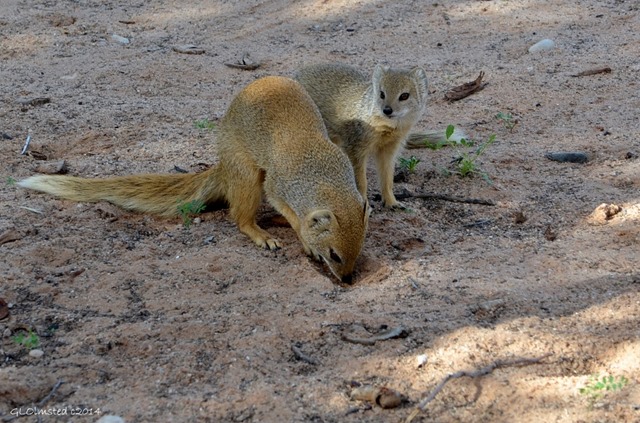 The five hour drive to Mata Mata camp was brutal with very rough road shaking Joan’s poor truck apart and we had planned to stay there 3 nights. But one was enough in the not very impressive campground by SANParks standards. We managed to trade our remaining nights there for Twee Rivieren where we entered the park. The yellow mongoose in camp digging for grubs was quite entertaining.
The five hour drive to Mata Mata camp was brutal with very rough road shaking Joan’s poor truck apart and we had planned to stay there 3 nights. But one was enough in the not very impressive campground by SANParks standards. We managed to trade our remaining nights there for Twee Rivieren where we entered the park. The yellow mongoose in camp digging for grubs was quite entertaining.
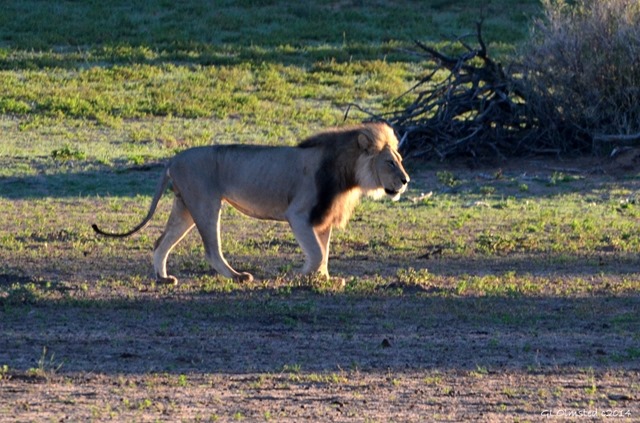 The next day’s early morning drive again brought lions. First a lioness headed to a waterhole straight towards a herd of springbucks and we thought maybe she’d give chase and make a kill. How exciting that would be. But then a male followed and after they’d both had a drink they mated. My second time seeing this activity.
The next day’s early morning drive again brought lions. First a lioness headed to a waterhole straight towards a herd of springbucks and we thought maybe she’d give chase and make a kill. How exciting that would be. But then a male followed and after they’d both had a drink they mated. My second time seeing this activity.
 Hanging out by a waterhole offers the best wildlife sightings in this otherwise dry environment. We saw many herds of Gemsbok, the symbol of the Kgalagadi, which I think are the most majestic of the many antelopes seen in South Africa. Many of the antelopes have expressive faces with the almost war paint like markings.
Hanging out by a waterhole offers the best wildlife sightings in this otherwise dry environment. We saw many herds of Gemsbok, the symbol of the Kgalagadi, which I think are the most majestic of the many antelopes seen in South Africa. Many of the antelopes have expressive faces with the almost war paint like markings.
 The third morning we drove the same nearby road into the dunes and saw more Gemsbok, ground squirrels, black-backed jackals, springbucks, butterflies and birds.
The third morning we drove the same nearby road into the dunes and saw more Gemsbok, ground squirrels, black-backed jackals, springbucks, butterflies and birds.
 Pretty much the same on the fourth day along with a group of hyenas napping in the shade.
Pretty much the same on the fourth day along with a group of hyenas napping in the shade.
 Plus we saw a Gemsbok with a very unusual horn. At first we thought it was growing into its eye but it was just curved in front. Although it may have been born with this deformity it’s more likely the horn was broken during a fight.
Plus we saw a Gemsbok with a very unusual horn. At first we thought it was growing into its eye but it was just curved in front. Although it may have been born with this deformity it’s more likely the horn was broken during a fight.
 Both the Nossob or Auob rivers were dry, but water runs underground and drilled wells provide water to animals. Many of these wells were dug at the beginning of World War I to provide troops with water in case of an invasion into South West Africa. Guards were recruited to maintain and protect the boreholes and settled with their families and livestock. After the war they stayed on, however it was a struggle to survive in this harsh environment and eventually hunting denuded the game. In 1931 the Kalahari Gemsbok National Park was established to protect the remaining wildlife. It may look green in these images but the Kalahari typically only receives 3-7 inches of rain a year at best.
Both the Nossob or Auob rivers were dry, but water runs underground and drilled wells provide water to animals. Many of these wells were dug at the beginning of World War I to provide troops with water in case of an invasion into South West Africa. Guards were recruited to maintain and protect the boreholes and settled with their families and livestock. After the war they stayed on, however it was a struggle to survive in this harsh environment and eventually hunting denuded the game. In 1931 the Kalahari Gemsbok National Park was established to protect the remaining wildlife. It may look green in these images but the Kalahari typically only receives 3-7 inches of rain a year at best.
 When we reserved for seven days the Kgalagadi website indicated that some roads were drivable by sedan and more were 4×4 only. We only stayed 4 days because all the roads were terrible. We tried to change out the remaining reservation for nights at Augrabies Falls National Park but were told no. Joan sent an email to the park manager about the road problem and was told some road grading equipment was broken, but no refund. Since then they’ve changed their website to read the roads “are not sedan friendly.”
When we reserved for seven days the Kgalagadi website indicated that some roads were drivable by sedan and more were 4×4 only. We only stayed 4 days because all the roads were terrible. We tried to change out the remaining reservation for nights at Augrabies Falls National Park but were told no. Joan sent an email to the park manager about the road problem and was told some road grading equipment was broken, but no refund. Since then they’ve changed their website to read the roads “are not sedan friendly.”
 I was a little disappointed after the eight other amazing national parks visited. However it was still a very interesting landscape with wildlife and I’d like to go back with a 4×4 as we barely saw any of the park. Plus I really want to stay in camps with no fences to feel more a part of the place. Maybe next visit will be time to also explore neighboring Namibia.
I was a little disappointed after the eight other amazing national parks visited. However it was still a very interesting landscape with wildlife and I’d like to go back with a 4×4 as we barely saw any of the park. Plus I really want to stay in camps with no fences to feel more a part of the place. Maybe next visit will be time to also explore neighboring Namibia.






